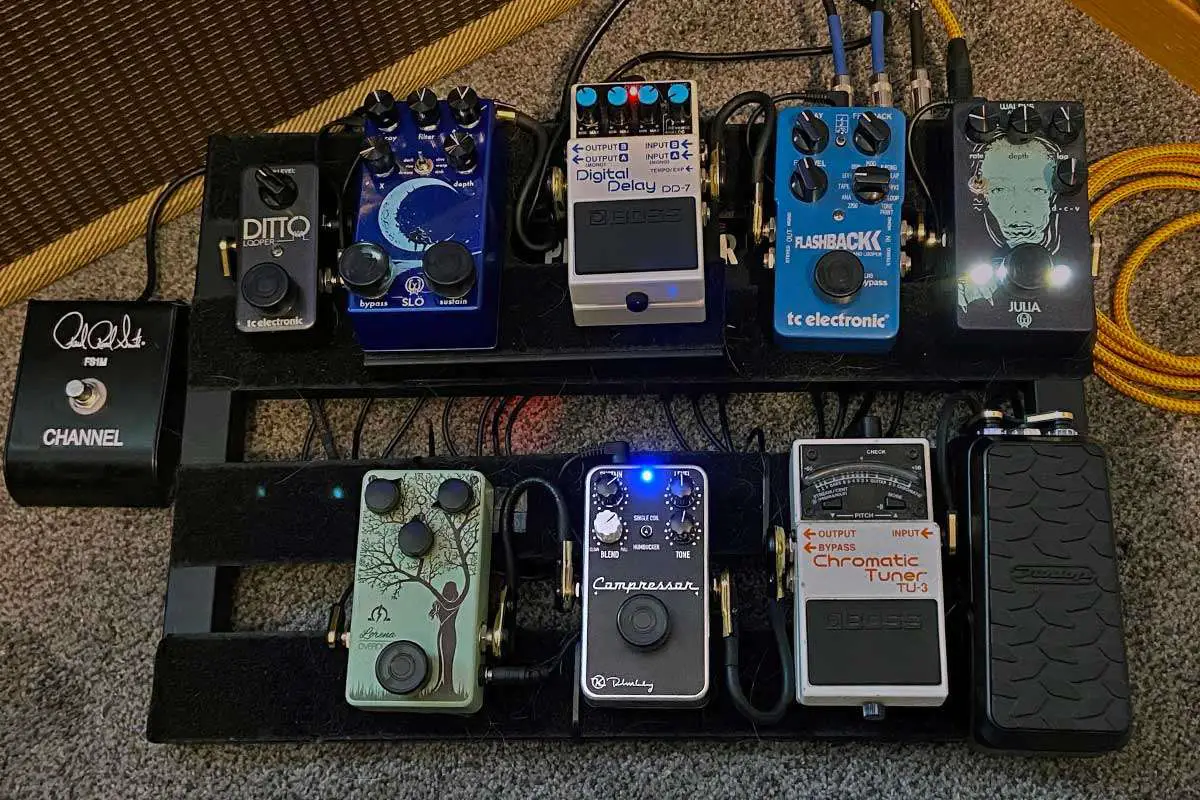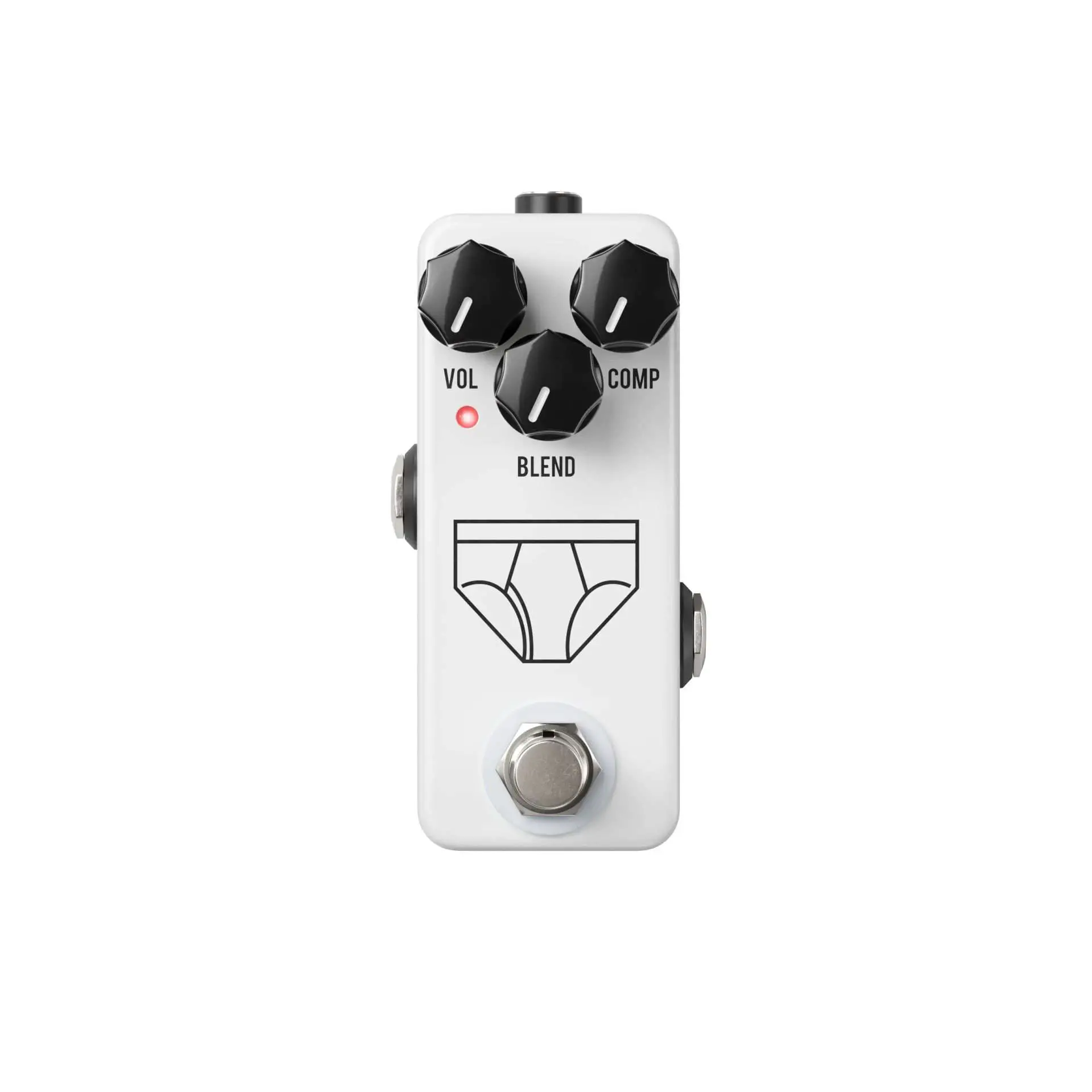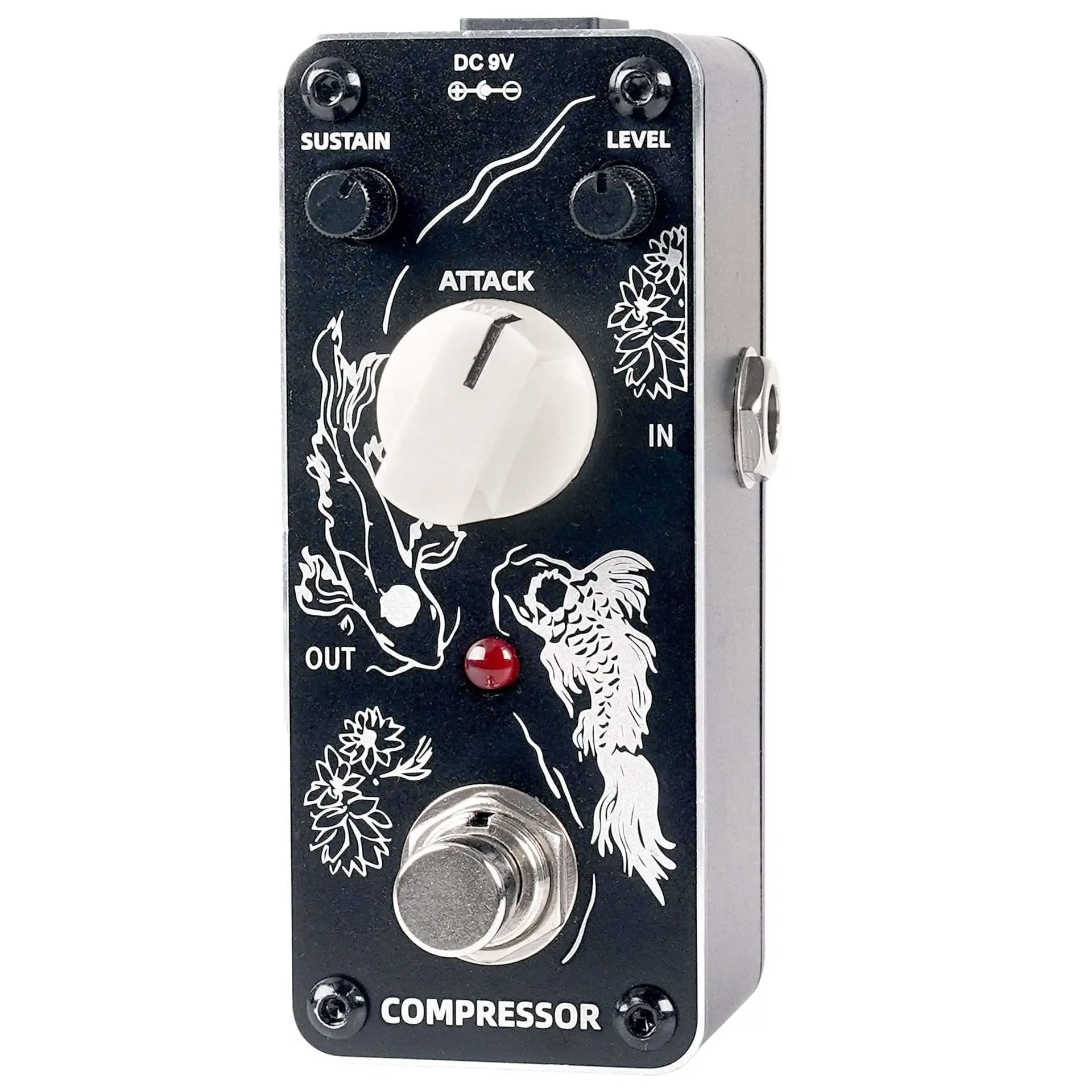In the realm of music production and live performance, choosing the best compressor pedal can play a crucial role in ensuring a polished final sound. One of the tools at a musician’s disposal for controlling these dynamics is a compressor pedal, a device often used to smooth out the volume levels by reducing the dynamic range of an audio signal. When operating at its best, a compressor pedal can enhance sustain, accentuate the nuances of your playing, and provide a consistent level of sound, which can be especially beneficial for live performances.
The specific type of compressor pedal one might choose depends largely on the instrument, musical genre, and personal preference. For guitarists, compressor pedals can mean the difference between a choppy, unbalanced signal and a smooth, professional-sounding tone. While the underlying concept of compression is fairly straightforward, the market offers an array of compressor pedals, each with unique features, from simple single-knob units to complex multi-control options.
When shopping for the best compressor pedal, key considerations include the pedal’s controls, such as attack, release, ratio, threshold, and make-up gain, as these impact how the compression is applied and affect the overall sound. Additionally, the quality of the electronic components and the pedal’s build can influence both the sound and the durability. Understanding these factors is essential for selecting a compressor pedal that not only meets your specific needs but also withstands the rigors of use, whether in the studio or on stage.
Our extensive evaluation and testing of various compressor pedals across different price points and features are designed to present you with options that elevate your playing and allow for fine control over your sound dynamics.

Top Compressor Pedals for Musicians
Compressor pedals are essential tools for guitarists looking to achieve a balanced sound and enhance sustain. We have carefully selected a range of these pedals that stand out for their performance, durability, and value. Whether you’re playing live gigs or recording in the studio, our list includes options that can cater to your specific needs and help you refine your tone.
Keeley Compressor Plus

We find the Keeley Compressor Plus to be an invaluable tool for crafting that polished, studio-quality sound on any guitar rig.
Pros
- Intuitive Tone Control enhances musical harmonics
- Blend Control preserves natural guitar dynamics
- Release Switch optimizes compression for your pickup type
Cons
- Premium price point compared to budget models
- Advanced features may overwhelm beginners
- Visible footprint on a crowded pedalboard
In our experience, the Keeley Compressor Plus breathes life into our guitar’s sound. The additional Tone Control is a standout, as it brings out the sweet, delicate harmonics often lost during compression. When balancing different guitars in a mix, this pedal gives us the edge, ensuring every note is clear and present without muddying the overall sound.
The Blend Control is another feature we find particularly useful. It helps retain the guitar’s natural peaks, keeping the performance lively and dynamic. This is crucial for us because we strive to maintain the integrity of the original signal while reaping the benefits of compression.
Equally impressive is the Release Switch, a simple yet effective innovation. It takes the guesswork out of setting up for different types of pickups. We notice that our humbuckers sound punchy and defined, making this pedal a versatile asset for players with a diverse guitar collection.
It’s clear that this compressor is built by a team who understands what musicians need – it not only fortifies our tone but also makes playing more enjoyable. Whether it’s on stage or during a studio session, we find the Keeley Compressor Plus to be a faithful companion for our sound adventures.
Mini Ego Compressor

We found the Mini Ego Compressor to be an indispensable tool for achieving a smooth, even guitar tone without sacrificing dynamics.
Pros
- Compact size fits any pedalboard
- Blend control preserves natural guitar sound
- Versatile tone and attack switches
Cons
- May require some tweaking to find sweet spot
- The price point could be high for budget-conscious musicians
- Bright switch might be subtle for some tastes
In our hands-on experience, the Mini Ego Compressor slid onto our pedalboard with ease, thanks to its compact footprint. It felt sturdy; the knobs and switches responded well to our adjustments, reminiscent of the reliable, no-nonsense gear we appreciate. Whether it was refining gentle fingerpicking or leveling out heavy strumming, this pedal proved its worth quickly, offering plenty of headroom.
Tweaking the blend knob gave us a striking clarity that let our guitar’s true voice shine through, unobstructed. It was a relief to find we could dial in the right amount of compression without any hint of artificiality or squashing the life out of the signal. We’ve seen plenty of pedals that color the sound too much, but the Mini Ego adds just enough to sweeten the signal.
As we fiddled with the tone and attack switches, the Mini Ego revealed its flexibility—darkening or brightening our tone, as well as varying the responsiveness to our playing. The effect was subtle yet effective, showcasing the pedal’s capacity to adapt to different styles, a must-have for studio sessions or live gigs where versatility is key. It’s become clear to us why the Mini Ego Compressor is regarded as a staple in the guitar world. Its performance is a balancing act of precision and musicality.
JHS Whitey Tighty Compressor

Whether you’re a gigging guitarist or a bedroom rockstar, the Whitey Tighty from JHS Pedals will keep your tone consistently polished without stealing the spotlight.
Pros
- Simplifies your pedalboard with its small footprint and intuitive three-knob layout
- Offers a versatile range of compression from gentle tightening to a more pronounced squash
- The blend knob allows for precise mixing of compressed and clean signals, maintaining your guitar’s natural character
Cons
- Some may find the compression character, although professional, a bit too subtle for extreme effect usage
- The small size, while convenient, can make the knobs a bit fiddly for those with larger hands
- High-quality compression means you might pay a little more than some entry-level options
The moment we plugged in the Whitey Tighty, its performance spoke volumes. Its FET-based compression added a studio-quality sheen to our tone that felt like an engineer was polishing our sound in real time.
Using it felt intuitive; a twist of the volume knob easily combatted any signal loss, while the compression knob let us smoothly transition from a subtle lift to a tight squeeze without ever compromising our tone’s integrity.
As someone who values pedalboard real estate, the Whitey Tighty’s small size is a game-changer. We were able to tuck it into a tight corner, leaving room for more of our favorite effects. The blend knob is the unsung hero here, letting us mix just the right amount of dry signal back with the wet, ensuring that the essence of our guitar’s sound was always present.
Boss CS-3 Sustain Pedal

We can confidently say that the Boss CS-3 Compressor/Sustainer is an essential stompbox for musicians looking to elevate their sound with consistent tone and sustain.
Pros
- Enhances sustain without altering original tone
- Provides a smooth, uniform sound for varied playing styles
- Built with durable construction that’s road-ready
Cons
- May require some tweaking to avoid tone coloring
- Could be less intuitive for beginners
- The noise level may increase with higher sustain settings
Playing with the Boss CS-3 gives us a real sense of control over our sound, especially for those instances where we want to stand out during a solo or ensure that every note is heard clearly in rhythm sections. The pedal’s ability to maintain a uniform tone while extending note sustain adds a professional polish to performances.
We’ve noticed the pedal’s ability to even out the dynamics of our playing. Whether we’re delicately fingerpicking or aggressively strumming, the output is balanced, making it invaluable for both live performances and studio recordings.
Lastly, the robust construction and the straightforward layout of the control knobs are impressive. Boss is known for making pedals that can take a beating without any compromise in functionality. Having put this pedal through its paces, we can attest to its reliability and ease of use, which is crucial when playing in variable environments.
Donner Ultimate Comp Pedal

We think the Donner Ultimate Comp Pedal is a must-have for any guitarist looking for even dynamics and a classic sound without breaking the bank.
Pros
- Smooths out your playing dynamics effectively
- Offers versatile sound shaping with tone and level controls
- The true bypass feature preserves your original signal
Cons
- Power adapter not included
- Some may find the compression too subtle for their taste
- Limited to only two modes for sound variety
The moment we plugged in the Donner Ultimate Comp Pedal, we were impressed with its ability to refine the sound without stripping away the guitar’s character. It feels like an extension of our setup rather than an intrusive effect. Whether we were strumming hard or picking gently, the pedal evened out the loud peaks and subtle dips flawlessly.
We found the control knobs intuitive; dialing in the right amount of compression, tone, and volume was a breeze. The versatility between NORMAL and TREBLE modes allowed us to adapt to different playing styles, which is especially handy for gigs that demand a broad sonic palette.
While the pedal is active, its true bypass design makes sure it remains transparent in the signal chain. We experienced no annoying pops or hisses that you sometimes get with other stompboxes, just pure, enhanced tone. However, we did need to source our own power supply, as the pedal doesn’t come with one.
In summary, whether you’re a seasoned pro or new to the effects game, we can confidently say the Donner Ultimate Comp Pedal adds a professional polish to your sound without complication or clutter.
Behringer CS400

After thorough testing, we recommend the Behringer CS400 for its ability to provide consistent sound levels and sustain for a variety of playing styles.
Pros
- Enhances sustain remarkably, keeping notes ringing for longer.
- Equalizes volume across all guitar strings effectively.
- Sturdy build quality for durability on the road.
Cons
- Tone control could offer a wider range to cater to all preferences.
- Plastic exterior may concern gigging musicians used to metal casings.
- Excludes power supply, necessitating an additional purchase.
Having recently gotten hands-on with the Behringer CS400, we were particularly impressed by how it smoothed out the dynamics of our playing. Whether we plucked strings softly or attacked them more vigorously, this pedal evened out the sound, giving a polished feel to our music.
The dedicated controls for level, attack, sustain, and tone were intuitive, allowing us to sculpt the sound swiftly to find the desired balance. Even when we pushed the sustain to its limits, the pedal did not compromise the original sound’s integrity, which is a testament to Behringer’s design.
In a live setting, the CS400 held its own. The on/off switch did its job without any pops or signal loss, which kept us confident in the heat of performance. While we would have loved a touch more nuance in the tone controls, the pedal still delivered a sonic punch that belied its price point.
We have to mention that the absence of an included power supply meant we had to raid our stash, but once powered up, the CS400 didn’t disappoint. Despite its plastic housing, the pedal felt robust enough for regular use, but we’d advise treating it with care to ensure longevity, especially for active musicians. For those looking for a reliable workhorse compressor without breaking the bank, the Behringer CS400 is a strong contender.
Sondery Compressor Pedal

We’re confident the Sondery Compressor Pedal offers solid performance with its artistic design and user-friendly controls, making it a valuable addition for any guitarist or bassist.
Pros
- Enhances tonal dynamics with precision
- Robust build with an engaging art design
- True bypass preserves signal integrity
Cons
- Lacks an included power source
- May sound grainy as per some users
- Some may find the sustain control limited
After strapping on our axe and plugging in the Sondery Compressor Pedal, we immediately notice the sustain, level, and attack controls allow for a fine-tuning of our sound. With a few simple tweaks, we’re able to add that punch to our rhythm playing and fluidity to our solos, without it ever feeling overwhelming or too squashy.
Its compact size and aluminum body make it a low-footprint addition to our pedalboard, saving valuable space without sacrificing durability. Plus, the art design contributes to a distinct aesthetic that stands out amidst a sea of black and metal pedals.
Despite its solid construction, do keep in mind that you’ll need to source a separate 9V power supply. While this is a minor setback, once powered, we appreciate the pedal’s quiet operation—a noticeable lack of background noise even when we’re pushing the pedal to its limits.
For the price point, the Sondery Compressor Pedal is a surprise package. Granted, some of us craved a bit more from the sustain knob, but within moments we found a setting that suited our style, adding a harmonious balance to our instrument’s voice. For guitarists and bassists in search of an affordable compressor that won’t color their tone too much, we think it’s worth giving this pedal a shot.
Kmise Compressor Pedal

After thorough testing, we believe this pedal should be on your board for its silent operation and consistent sustain.
Pros
- Reduces noise effectively for quieter performance
- True bypass feature preserves the guitar’s original tone when the pedal is off
- Robust aluminum alloy construction ensures durability for gigging musicians
Cons
- Requires an external 9V adapter which is not included
- Limited to three knobs, which might not satisfy all tonal tweaking needs
- The mini size might be difficult to operate for players with larger feet
When we plugged in the Kmise Compressor, the first thing we noticed was the pedal’s ability to tame the signal without sucking the life out of our playing dynamics. The noise reduction is top-notch, ensuring a clean signal path even with high gain settings.
The true bypass design caught our attention, maintaining our guitar’s pure tone. We appreciated this clarity and it’s a big plus for tone purists who want the pedal’s effect without any coloration when bypassed.
Gigging can take a toll on gear, but this compressor’s aluminum alloy body felt rugged enough to withstand the rough and tumble. Despite its small footprint, the pedal felt stable underfoot – a real advantage when stage space is at a premium.
However, those of us with a penchant for tweaking might find the three-knob layout limiting. We could dial in a good sound, but options for fine-tuning were somewhat restricted. Also, keep in mind the need for a separate 9V adapter, as some may find it inconvenient.
If a resilient, performance-ready compressor with a no-nonsense setup is what you’re after, the Kmise Compressor could very well be the workhorse on your pedalboard.
Buying Guide
Understanding Your Needs
Before selecting a compressor pedal, we should evaluate what we require in terms of dynamics control. If our playing style varies from quiet picking to aggressive strumming, a pedal with a broader range of compression could serve us well.
Related: How do guitar pedals work
Key Features to Consider
Sustain: The ability to hold a note for longer periods.
Attack: How quickly the compression effect starts after a note is played.
Release: The time it takes for the sound to return to its uncompressed state.
Level: Controls the output volume of the compressed signal.
Ratio: The proportion of input signal to output signal.
Controls and Usability
We must ensure that the pedal interface is user-friendly. A pedal with intuitive controls will be easier for us to adjust settings quickly.
Performance and Durability
A compressor pedal that offers low noise and consistent performance is a must. Additionally, we should seek out robust construction to withstand regular use.
| Feature | Importance | Why It Matters |
|---|---|---|
| Sustain | High | Extends the life of notes |
| Attack | Medium to High | Shapes the initial sound |
| Release | Medium | Affects note decay |
| Level | High | Balances signal post-compression |
| Ratio | High | Determines compression severity |
Versatility
A compressor pedal that provides versatility might offer a range of tones, which can be beneficial for those of us who play different genres or styles.
True Bypass
Pedals with true bypass ensure that our tone remains uncolored when the compressor pedal is disengaged.
By considering these features, we can make an informed decision on which compressor pedal might best fit our musical needs and preferences.
